So this is supposed to be my 3rd or 4th post (by right) since I had planned for this blog for quite some time and have been actively experimenting with cooking for a couple of weeks prior (and after watching Julie & Julia…!). The thought of making my own bread came up a couple of weeks ago when I bought a loaf of baguette from my neighbourhood Tesco (Seri Alam) to eat with my newly learnt ‘Perfect Scrambled Eggs’ (a truly delicious and amazing recipe from Gordon Ramsay, who I will reference quite a bit in this blog).
It was one of the most terrible experiences I’ve ever had with eating a loaf. It was so ridiculously dry and dense, and I reckon it had the potential to be a murder weapon if one so desired. It was rock solid, the crust wasn’t even crisp and cutting into it with a bread knife was a workout in itself. Eating it was even worse, and practically left my mouth with scars from all that hard masticating and sharp edges of the crust, with my gums bleeding on a couple of occasions too. I tried rectifying it later by steaming it first for about 10 minutes before popping it into the toaster at 150 centigrade for 10 minutes topped with butter. It KINDA worked a little, as it wasn’t so rough on the palate after that, having had time for the crumb to absorb the moisture and the butter, although the overworked gluten meant the crumb was too tough and dense.
A truly terrifying experience, and the most wasteful RM 1.69 I ever spent .
So anyway, back story aside, I read up pretty excitedly on French loaf recipes, methods and watched videos on how to go about making one. The ingredients for a classic French Loaf is mind bogglingly few- only 4. I was pretty intrigued that a simple mix of flour, water, salt and yeast could turn into one of the most delicious form of foods ever discovered by men- and also one of my favourite foods ever.
So this morning (which I might tend to call “yesterday night”, since I slogged in the kitchen from 1 – 6 am to do a variety of things including cleaning), I decided to try making my own French loaf. I was running low on bread flour (which has a higher gluten content specifically for bread making purposes), so I had to halve the recipe. I decided on this ‘Perfect French Loaf‘ recipe from Jaden Hair of Steamy Kitchen based on the how the loaf in the picture turned out (golden brown) together with the simplicity of the ingredients required (the ones from AllRecipes called for other ingredients like butter, milk and eggs, which I wanted to avoid as I was running low on all of them too, esp the eggs which were required for my profiteroles).
So I measured everything out as per stated by the recipe, mixed it using my hand mixer. This is post-shagginess, and after letting it rest before mixing it again:
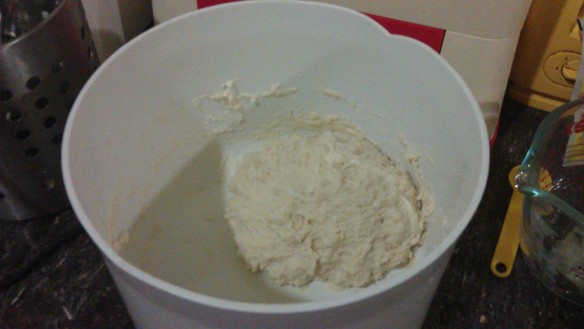
After that, I spent about 10 minutes kneading it trying to achieve a satiny, smooth texture. After sweating like a pig (even with the fan on and circulating) and hands tired from all that pushing and pulling, I tried googling bread troubleshooting- because I was so worried that it didn’t achieve a satiny look and feel like how the picture on the blog looked.

Now, all I had was my the 4.3″ screen of my phone, two dusty, floury hands and a shitty WiFi connection with only 1 bar as my phone was downstairs while my router was upstairs. So it was a harrowing and clumsy back and forth between my dough and my phone trying to find out why my bread wasn’t satiny even after kneading it for so long. In the end I came across a SIMILAR question on an artisan baking site, but as usual, people were being dolts and the discussion over a simple bloody question escalated into a uber long, walls of text bitchfight over butthurt egos by people who obviously need to spend less time on the internet and more time in the kitchen.
So anyway, the point was that my question was unanswered, so I decided to just stop kneading it 5 minutes later (because I read that the dough should not be overworked lest the crust turns out like chuck norris’ bollocks) and put it aside for resting by placing my dough into an oiled bowl and then a plastic bag over it.
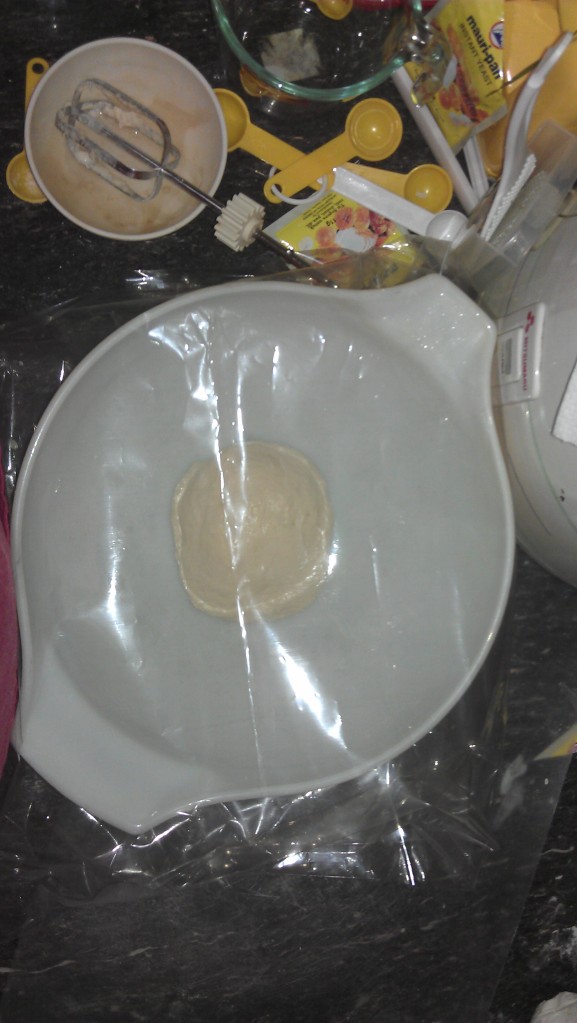
So I sat down, somewhat tired and tried going through the steps so I could commit it to memory… when it suddenly dawned on me:
I halved the recipe… but left out halving the salt.
I uttered one of the loudest fucks I ever, tweeted about it and scrambled to Google (my BFF) to try troubleshooting for over-salted bread dough. Someone over on Yahoo Answers suggested making a salt-less dough and mixing the two together. Others said to just throw it away because nothing could be done.
So with not much more than a cup of bread flour left, I continued searching the net for more ideas, but sadly, couldn’t find any more. Or maybe I wasn’t searching properly, IDK. I just left it alone and hoped for the best.
I was supposed to let it rest for 1.5 hours, where, 1 hour into the rising process, I was to preheat the oven to 220 centigrade. I knew that too much salt would be retarding the activity of the yeast- or probably even kill those little buggers off outright, so I hoped for the best that I didn’t actually kill them off, and on an utterly random idea, I switched the oven’s light on to try to make the yeast work faster by making the environment warmer.
It didn’t actually work, because the light was just too weak. So I cranked the heat up to the 60 centigrade mark and let it preheat while I went to clean my stuff up. It was sufficiently warm inside, so I turned the heat back to 0 and placed my dough inside, again, hoping for the best.
I busied myself making pate a choux for the cream puffs I wanted to make for my brother and mum while waiting for the dough to rise… and then I made ANOTHER mistake.
I completely forgot that I only had 2 eggs instead of 4 and measured the butter, salt and sugar for a recipe calling for 4 eggs. And I realised that only after I boiled my butter and water mix.
Doh.
Panicking because I didn’t want the butter mix to go to waste, I decided on stirring the mixture, measuring the volume out and then halving it. It was an imperfect idea from the start, since the mix could never emulsify or stay together long enough for me to adequately measure it out and halve it.
While stirring my flour into it, I intuitively knew that there was too much water and not enough fats and that it wouldn’t turn out very well. So I added a little more flour (about a 1/4 cup more) in the hopes of salvaging it.
I should have just started over, but then my family’s not very well off and butter is a rather expensive thing to have, so I tried to salvage what I could. I ended up having an unnervingly soft pastry dough, though. On hindsight, I should have just frozen the mixture in an even container and divided the resulting frozen thing into two. I won’t know if it would actually work perfectly, but hey, it couldn’t be worse than my initial method, right?
Anyway, it surprisingly SORTA worked, although my shells came out without much of a good rise and with a flaccid softness to it (which I detest but my mum liked -shrugs-).
 To me, a good profiterole shell should be hard and firm on the outside, airy, empty and dry on the inside, but with a good, tender mouthfeel that doesn’t suggest dryness or overdoneness- which was exactly what I achieved on my first try with Julia Child’s recipe (which is currently my favourite, although I made minor amendments to the baking time and sugar content, which I will blog about in a separate post). This one was a little undercooked inside 5 minutes into the baking time, so I lowered the temp to 150 and baked it a little longer for another 5 minutes.
To me, a good profiterole shell should be hard and firm on the outside, airy, empty and dry on the inside, but with a good, tender mouthfeel that doesn’t suggest dryness or overdoneness- which was exactly what I achieved on my first try with Julia Child’s recipe (which is currently my favourite, although I made minor amendments to the baking time and sugar content, which I will blog about in a separate post). This one was a little undercooked inside 5 minutes into the baking time, so I lowered the temp to 150 and baked it a little longer for another 5 minutes.
So all in all, the baking time was reduced by about 5 minutes from the original 15 needed.
While my profiteroles were baking, I set about making a faux whipped cream with butter, sugar and milk. Which honestly sucked monkey balls because the amount of butter used was too little to properly whip and distribute the sugar inside well enough- the end result was grainy and crunchy, really disgusting, though my brother was polite enough to say it in a nice manner. LOL. I learnt that I should continue beating it until I can’t feel the crunchiness…. hmm.
After completing my failure of a profiterole, I checked back on my dough… and was so surprised and pleased:
IT ACTUALLY WORKED! My dough had risen and almost doubled in size! In my excitement and haste to actually work on it, I forgot to snap a picture of it. Doh.
So I did the tucking thing and karate chop thing in and let it rest on a damp tea towel for about 10 minutes:
 And then I transferred them out to make scores, which was honestly the most exciting part for me. (I’m weird that way.)
And then I transferred them out to make scores, which was honestly the most exciting part for me. (I’m weird that way.)

Heated oven: Check
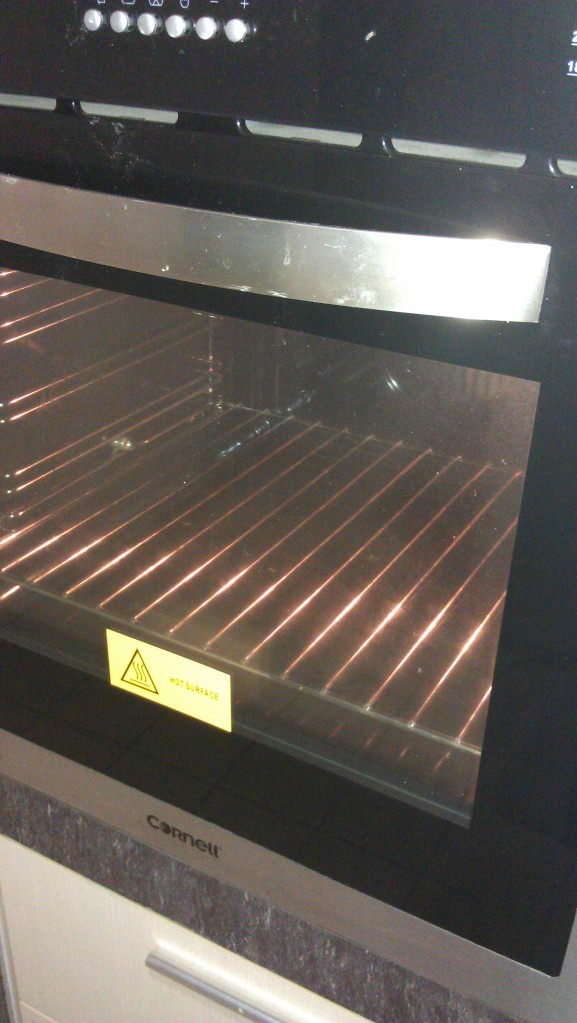
Steam maker: Check
 Loaves in oven: Check
Loaves in oven: Check

And so the agonizing wait began. Well, not really, since I had Josh Groban to accompany me through the lonely night. Heh.
My excited thought: OMG IT ROSE!
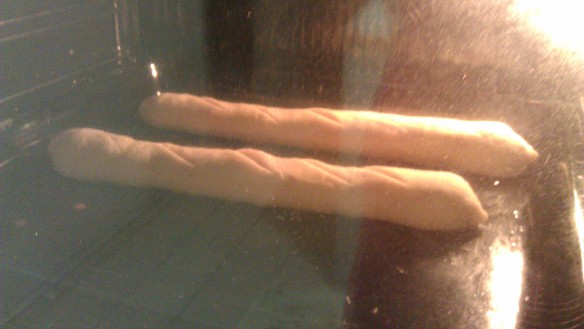
But there was still about 20+ minutes to go.
About 5 minutes or so later, I got a terrible shock: The one at the back burst open! I almost felt like crying. It appears I need to practice more on my sealing and shaping method. 😦

The end result: A loaf with a nice, crisp crack upon slicing, but with a salty dense crumb
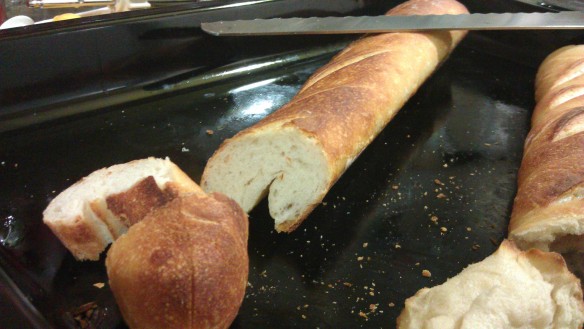
The one that burst is on the right:

Profiteroles (sorta) saved the day! nyom nom nom~

And that concludes my suuuuper long first post. It was a mistake-filled day, but my motto has always been: if I don’t make mistakes, I’ll never learn! (I don’t care if I’m trying to make myself feel better about my innate clumsiness) I shall attempt to make a new loaf after I’ve gone to get more bread flour. Til then, bon appetit!




















































